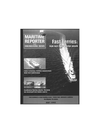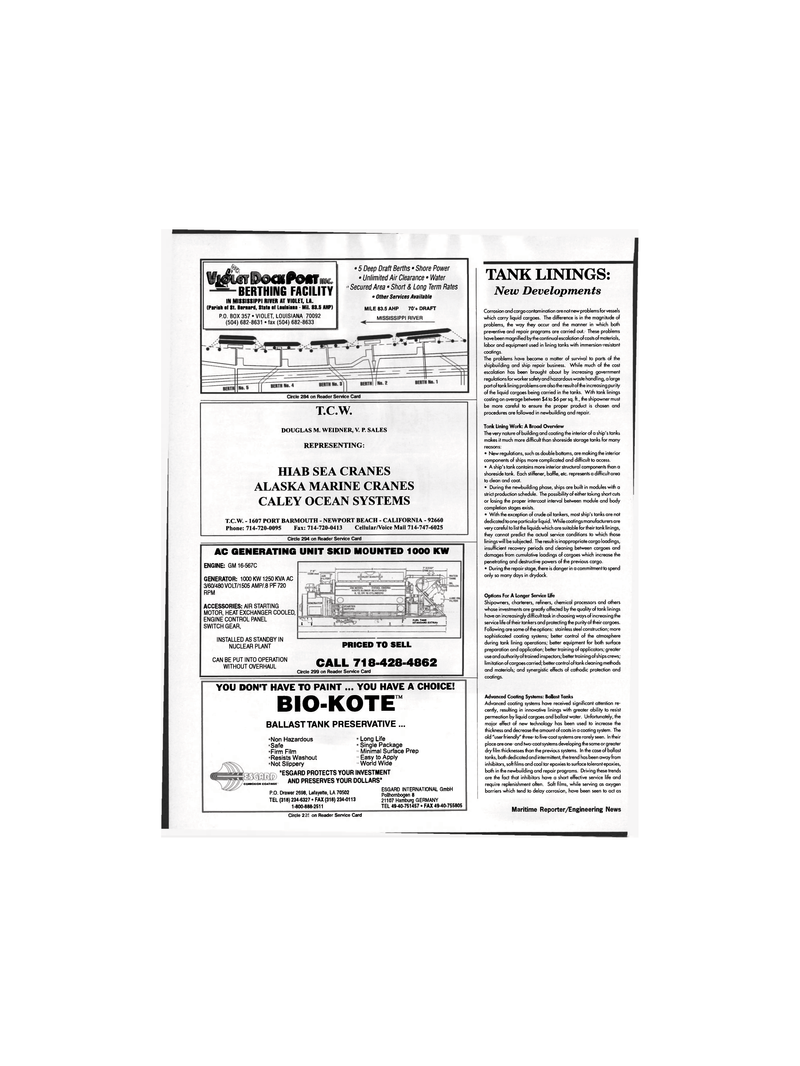
Page 56: of Maritime Reporter Magazine (May 1995)
Read this page in Pdf, Flash or Html5 edition of May 1995 Maritime Reporter Magazine
Vj^urltoaiflotr
BERTHING FACILITY
IN MISSISSIPPI RIVER AT VIOLET, LA. (Parish of St. Bernard, State ol Louisiana - Mil. 83.5 AHP)
P.O. BOX 357 • VIOLET, LOUISIANA 70092 (504) 682-8631 • fax (504) 682-8633 • 5 Deep Draft Berths • Shore Power • Unlimited Air Clearance • Water < Secured Area • Short & Long Term Rates • Other Services Available
MILE 83.5 AHP 70'+ DRAFT
MISSISSIPPI RIVER
Circle 284 on Reader Service Card
T.C.W.
DOUGLAS M. WEIDNER, V. P. SALES
REPRESENTING:
HIAB SEA CRANES
ALASKA MARINE CRANES
CALEY OCEAN SYSTEMS
T.C.W. - 1607 PORT BARMOUTH - NEWPORT BEACH - CALIFORNIA - 92660
Phone: 714-720-0095 Fax: 714-720-0413 Cellular/Voice Mail 714-747-6025
Circle 294 on Reader Service Card
AC GENERATING UNIT SKID MOUNTED lOOO KW
ENGINE: GM 16-567C
GENERATOR: 1000 KW 1250 KVA AC 3/60/480 VOLT/1505 AMP/.8 PF 720
RPM
ACCESSORIES: AIR STARTING
MOTOR, HEAT EXCHANGER COOLED,
ENGINE CONTROL PANEL
SWITCH GEAR,
INSTALLED AS STANDBY IN
NUCLEAR PLANT
CAN BE PUT INTO OPERATION
WITHOUT OVERHAUL : i;
X l! G' FUEL TANK * (STANDARD EXTRA)) )
I
PRICED TO SELL
CALL 718-428-4862
Circle 299 on Reader Service Card
YOU DON'T HAVE TO PAINT ... YOU HAVE A CHOICE!
BIO-KOTE™
BALLASTTANK PRESERVATIVE...
Non Hazardous
Safe
Firm Film
Resists Washout
Not Slippery
Long Life
Single Package ' Minimal Surface Prep 1 Easy to Apply • World Wide
CORROSION COATINGS ~ "ESGARD PROTECTS YOUR INVESTMENT
AND PRESERVES YOUR DOLLARS"
P.O. Drawer 2698, Lafayette, LA 70502
TEL (318) 234-6327 • FAX (318) 234-0113 1-800-888-2511
ESGARD INTERNATIONAL GmbH
Pollhombogen 8 21107 Hamburg GERMANY
TEL 49-40-751457 • FAX 49-40-755805
Circle 209 on Reader Service Card
TANK LININGS:
New Developments
Corrosion and cargo contamination are not new problems for vessels which carry liquid cargoes. The difference is in the magnitude of problems, the way they occur and the manner in which both preventive and repair programs are carried out. These problems have been magnified by the continual escalation of costs of materials, labor and equipment used in lining tanks with immersion-resistant coatings.
The problems have become a matter of survival to parts of the shipbuilding and ship repair business. While much of the cost escalation has been brought about by increasing government regulations for worker safety and hazardous waste handling, a large part of tank lining problems are also the result of the increasing purity of the liquid cargoes being carried in the tanks. With tank linings costing on average between $4 to $6 per sq. ft., the shipowner must be more careful to ensure the proper product is chosen and procedures are followed in newbuilding and repair.
Tank Lining Work: A Broad Overview
The very nature of building and coating the interior of a ship's tanks makes it much more difficult than shoreside storage tanks for many reasons: • New regulations, such as double bottoms, are making the interior components of ships more complicated and difficult to access. • A ship's tank contains more interior structural components than a shoreside tank. Each stiffener, baffle, etc. represents a difficult area to clean and coat. • During the newbuilding phase, ships are built in modules with a strict production schedule. The possibility of either taking short cuts or losing the proper intercoat interval between module and body completion stages exists. • With the exception of crude oil tankers, most ship's tanks are not dedicated to one particular liquid. Whilecoatings manufacturers are very careful to list the liquids which are suitable for their tank linings, they cannot predict the actual service conditions to which those linings will be subjected. The result is inappropriate cargo loadings, insufficient recovery periods and cleaning between cargoes and damages from cumulative loadings of cargoes which increase the penetrating and destructive powers of the previous cargo. • During the repair stage, there is danger in a commitment to spend only so many days in drydock.
Options For A Longer Service Life
Shipowners, charterers, refiners, chemical processors and others whose investments are greatly affected by the quality of tank linings have an increasingly difficult task in choosing ways of increasing the service life of their tankers and protecting the purity of their cargoes.
Following are some of the options: stainless steel construction; more sophisticated coating systems; better control of the atmosphere during tank lining operations; better equipment for both surface preparation and application; better training of applicators; greater use and authority of trained inspectors; better training of ships crews; limitation of cargoes carried; better control of tank cleaning methods and materials; and synergistic effects of cathodic protection and coatings.
Advanced Coating Systems: Ballast Tanks
Advanced coating systems have received significant attention re- cently, resulting in innovative linings with greater ability to resist permeation by liquid cargoes and ballast water. Unfortunately, the major effect of new technology has been used to increase the thickness and decrease the amount of coats in a coating system. The old "user friendly" three- to five-coat systems are rarely seen. In their place are one- and two-coat systems developing the same or greater dry film thicknesses than the previous systems. In the case of ballast tanks, both dedicated and intermittent, the trend has been away from inhibitors, soft films and coal tar epoxies to surface tolerant epoxies, both in the newbuilding and repair programs. Driving these trends are the fact that inhibitors have a short effective service life and require replenishment often. Soft films, while serving as oxygen barriers which tend to delay corrosion, have been seen to act as 58 Maritime Reporter/Engineering News

 55
55

 57
57
